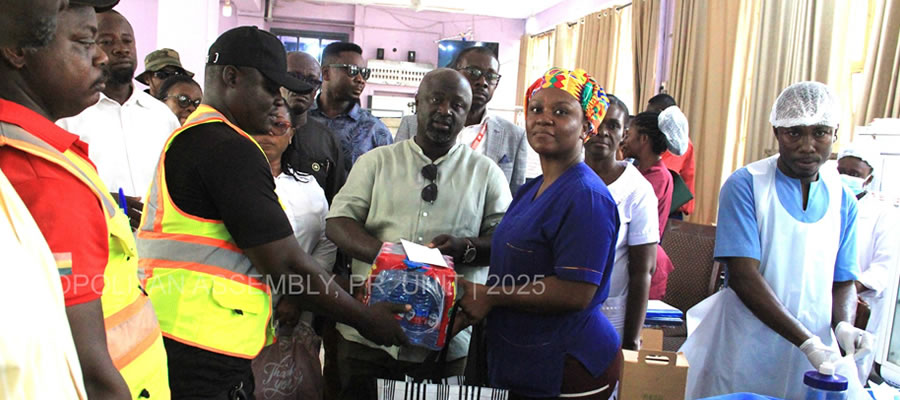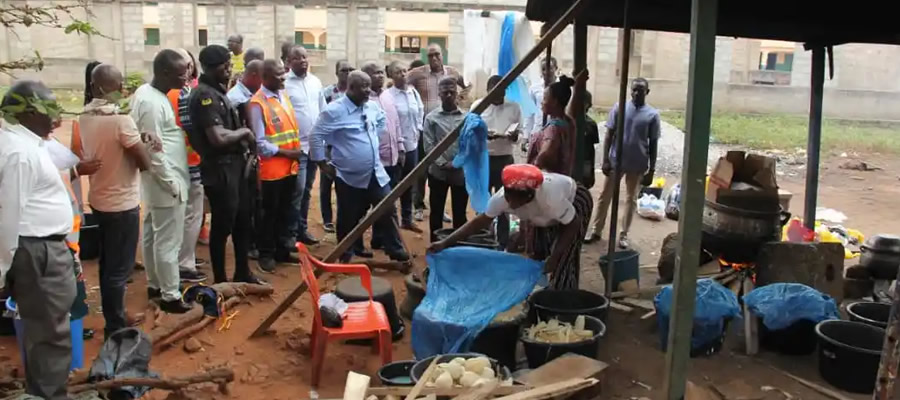

Health Care
The Metropolitan Health Services are organized around five (5) Sub Metro Health Teams; namely, Bantama, Asokwa, Manhyia North, Manhyia South and Subin. The Metro Health Team is led by its Director of Health Services who has the overall responsibility for planning, monitoring and evaluating the performance of the Health Sector in the metropolis.
The city has a number of health facilities in both the public and private sectors. Notable among them are the Komfo Anokye Teaching Hospital (KATH), which is one of the two (2) national autonomous hospitals, four (4) quasi health institutions, five (5) health Care Centres owned by the Church of Christ and the Seventh-Day Adventist Church.
In addition, there are over two hundred (200) known private health institutions and 13 Industrial Clinics in the metropolis. There are also 54 trained Traditional Birth Attendants (TBAs), nine (9) Maternal and Child Health (MCH) points and 119-outreach sites. These facilities are evenly distributed in space. Table 9 shows categories of Health Facilities in Kumasi.
Service Provision
The Ghana Health Service working with the Private sector provides clinical and public Health Services. The clinical services include OPD, In- Patient, surgery, eye care, dental care, obstetrics and gynaecology etc. the Public Health Services include Expanded Programme on Immunisation, Reproductive and Child Health, Disease Control, Nutrition, Health Information Management, Social Mobilisation for Community Support, collaboration with other sectors and the community and the Environmental Health Department.
Access to Health Facilities in the Kumasi Metropolis
One can infer from the map that the facilities are evenly distributed in space. This coupled with the asphalted road network makes for ease in physical accessibility. Kumasi is therefore well placed in terms of distribution and accessibility.
Accessibility in terms of cost is however a thorny issue as the cost of procuring Medicare is high. To enhance financial accessibility to health delivery the government in 1997 came out with an exemption policy for some vulnerable groups. This policy gives free medical treatment including certain laboratory services to all pregnant women, the aged (above 65 years of age) and children less than 5 years of age. There is also the refund of medical bills incurred in public hospital to civil servants has been under the control of the Kumasi Metropolitan Assembly (KMA) in consultation of with the Metropolitan Health Directorate. However, with the passage of the National Health Insurance Bill in 2005, the Kumasi Metropolis had four District Mutual Health Insurance Schemes in operation (DMHIS) in the four Sub Metropolitan District Councils, namely; Subin, Bantama, Manhyia and Asokwa. This is expected to improve the financial accessibility to health care delivery in the Kumasi Metropolis.
Staffing of the Institutions
The staffing of the Metropolitan Health Facilities and the Metropolitan Health Management Team is shown in Table 29.
Analysis of the Table 31 shows that from the year 2003 to 2005 the Doctor/Patient Ratio has been reducing over the years. The implication is there that more patients chasing few doctors. It also reveals a situation of a not too good health delivery system. The rippling effects are lost of time resulting from chasing fewer doctors, a lethargic society and low productivity.
Infant Mortality Rate
A cursory glance at the indicators reveals that the number of infants who die per 1,000 live births each year continues to grow. It increased from 21 in 2003 to 29 in 2004 and 36 in 2005 representing an increase in percentage of 27.6 and 19.4 respectively.
The implication for development is that the population will not be replacing itself and the result will be an ageing population with a low human resource base. It will also impinge on productivity and the overall development of the metropolis.
Analysis of the figures above indicates that the maternal mortality rates in the periods under review have been high. In 2003 it was 3.7% of every 100,000 live births. It increased to 4.2% in 2004 and took a slight nose-dive in 2005 thereby settling at 3.9%.
The implications are that there are more orphans. The rippling effects are a high dependency load, lack of proper care, high school dropouts, and increase in crime, low human capital base and low productivity.
Common Diseases
The common diseases in the Metropolis include; malaria, diarrhea, HIV/AIDS, tuberculosis, hypertension, diabetes mellitus, Septic abortion and road traffic accident.
Hospital Attendance
Table 34 gives the pattern of attendance from 2002 to 2005 for some of the health facilities in Kumasi. From the figures captured in the table there is an indication that people patronize the public health facilities more than the private ones. This is attributable to the fact that relatively higher fees are charged by the private health facilities coupled with the fact some of the sophisticated and essential equipment are obtained at the public health facilities. This gap is expected to widen with the introduction of the District Mutual Health Insurance Scheme.
Specialized Services
OPD and Delivery Services can be accessed in all the five Sub Metro facilities and KATH. Skin or dermatological cases and psychiatric can be obtained at the Tafo Hospital whilst dental services can be accessed at the Suntreso and Kumasi South Hospitals. Treatment Sexually Transmitted Diseases can be gotten at the Suntreso as well as Maternal and Child Health Hospitals.
(a) Control of Malaria
Malaria is controlled by the roll back Malaria Concept. The activities involved include;
- Good Management of Malaria with Amodiaquine
- The use of Intermittent Prevention Treatment
- The use of insecticide Treated Nets
- Good environmental Management
(b) HIV/AIDS
Public and private health workers and Non-Governmental Organizations (NGOs) are working together in the area of HIV/AIDS in the Metropolis. The District Committee is the main agency responsible for HIV/AIDS control activities in the Kumasi Metropolis. It collaborates with health staff in the various hospitals in the implementation of its activities. It has drawn up a 5 Year Strategic Plan (2006-2010) for the fight against HIV/AIDS in the metropolis.
The main activities include;
Information, Education and Communication (IEC) on the disease.
Distribution of educational materials
Sale of condoms
Prevention of maternal to Child Transmission (PMTCT) of HIV/AIDS and Voluntary Counselling and Testing (VCT) services at Kumasi South, Suntreso, Tafo, Manhyia, and Maternal and Child Health Hospitals, Bomso Clinic, Aninwaa Medical Centre, KNUST hospital, Kwadaso, SDA Hospital and KATH.
Anti retroviral treatment at KATH, Kumasi South Hospital and Bomso Clinic.
Treatment of opportunities infections.
Data from 2004 Sentinal Survey reported a 3.1 per cent national rate for HIV/AIDS, 3.0 per cent prevalence rate for Ashanti and 2.4 per cent for the Kumasi Metropolis. It must be emphasized that a lot more cases of the disease are not reported. These figures are therefore for reported cases only.
(c) Adolescent Reproductive Health Services
Staff in almost all the public health institutions have been trained to offer services to adolescents. Four of the Sub Metro facilities except Tafo have their adolescent centers refurbished. Adolescent Reproductive Health activities take place both at the hospital and outside the hospital. It includes the prevention of teenage pregnancies, STIs and HIV//AIDS.
(d) Commercial Sex Workers (CSW)
The Suntreso STI Clinic deals with commercial sex workers in the metropolis. The activities of the STI Clinic include;
Mobilisation of sex workers, booth roamers and sitters
Home visiting
Health education
Treatment of STIs
Referral when necessary
Voluntary Counselling and Testing (VCT)
(e) Treatment of STIs
The treatment of STIs is carried out at Suntreso, Maternal and Child Health Hospital, Kumasi South Hospital as well as KATH. Some of the common STIs include gonorrhea, syphilis and Chlamydia. The treatment is through the diagnostic and syndromic approach.
(f) Rehabilitation of Malnourished Children
A total of 1,486 cases of malnourished children was recorded in children less than five years from January to June 2006. Rehabilitation of malnourished children is done at Manhyia and Maternal and Child Health Hospitals. A programme of Community Rehabilitation of malnourished children is to start to stop people from coming to the hospital frequently.
(g) Screening of Newborn Children
Since 1995, all newborn children in the Metropolis are screened of the sickle cell gene. This project was initiated and supported by Professor Ohene Frimpong of Philadelphia University of USA. The sickle cell project in the metropolis has four components.
These include:
Screening
Education and Counseling
Clinical and “mofra adamfo” concept
Clinical laboratory
From 13/2/95 to 30/6/2006 the total number of babies that have been contracted by the Metropolitan Health Staff through home visiting were 3189 (80%) and out of the total number contacted, 2556 (80%) have been enrolled at the sickle cell Clinic.
(h) District Mutual Health Insurance Scheme (DMHIS)
Table 39 shows the extent of implementation or registration of the District Mutual Health Insurance Scheme in the four Sub Metros namely; Manhyia, Bantama, Subin and Asokwa.
Analysis of the status of the DMHIS reveals a low patronage of the scheme. The four Sub Metropolitan District Councils, namely; Manhyia, Bantama, Subin and Asokwa stands at 10.5%, 7.2%, 12.3% and 8.7% respectively. A lot of education needs to be done.
Key Problems
Lack of office and residential accommodation for the Metro health staff
Inadequate staff (doctors, professional nurses and other paramedical personnel)
Inadequate budgetary allocation to the health sector and late release of funds for programmes.
Lack of transport for the institutions. Available vehicles are old and break down often.
Poor sanitation and lack of good environmental practices leading to Cholera outbreaks in 1998 and 1999.
Key Challenges
High and rising cost of health care
Exodus of health professionals
High doctor-patient ratio
Poor state of health infrastructure
Obsolete equipment
Prevalence of HIV/AIDS
Limited number of health training institutions
High morbidity and mortality rates
Low levels of motivation for health staff
Inadequate funding
Irregular release of funds
High communicable and non-communicable disease burden (malaria, HIV/AIDS, Cholera, Hypertension)
Poor National Health Insurance Registration
High Population growth
Potentials
The potentials and opportunities of the health delivery system in the Kumasi Metropolis include the availability of skilled labour force, committed staff, basic logistics, National Health Insurance Scheme (NHIS), global fund for tuberculosis and malaria control as well as technical support from Ghana Health Service and the Regional Health Administration.
The numerous health delivery outlets evenly distributed within the Metropolis.
The ease of physical accessibility to the health delivery outlets.
Provision of 24-hour health care services in some health facilities apart from KATH
Establishment of an ambulance rescue services to deal with emergencies.
Commissioning of Public Health Reference Laboratory (PHRL) to augment the diagnosis of patients and clients.
The competent medical staff manning the institutions
Exemptions to pregnant women, aged (above 70 years) and children under 5 years.
Decentralization of budgetary allocation for RHA to facilitate refund of medical expenses.
To sum up, it has been established that the number of health distribution outlets is adequate for the population of Kumasi and its surroundings. However, lack of adequate logistic support and high ratio of patients/doctor militate against equitable health delivery.
The Role And Responsibilities Of The Environment Health And Management Department
Background
In Ghana, Environmental Health conditions continue to be a major drain on the country’s weak economy due to high health expenditure and loss of productivity through lost man-hours. Environmentally related diseases are the major reasons for seeking medical care at the out patient departments in the country. These conditions include malaria, diarrhoeal diseases, upper respiratory infections, cholera, typhoid, skin and eye diseases, intestinal worms etc.
Definition of Environmental Health
Environmental Health comprises those aspects of human health, including quality of life, that are determined by physical, biological, social and psycho - social factors in the environment It also refers to the theory and practice of assessing, correcting, controlling and preventing those factors in the environment that can potentially affect adversely health of present and future generations"
Roles and Responsibilities
The Environmental Health and management Department is responsible for the software aspect of Environmental health in the metropolis as follows;
Environmental Protection and Standards Enforcement
1. Monitoring all environmental management activities in the metropolis
2. Providing back-up support to the lower levels of the Assembly
3. Disposal of the dead
4. Monitoring large industries in collaboration with other ministries, Departments and Agencies (MDAs) involved in Environmental management e.g EPA, WRC etc.
5. Serving on the statutory planning committee and the site Advisory Board of the Assembly
6. Prosecuting and effecting Bench Warrant arrest
Date Created : 11/28/2017 7:01:49 AM












 facebook
facebook
 twitter
twitter
 Youtube
Youtube
 +233 593 831 280
+233 593 831 280 0800 430 430
0800 430 430 GPS: GE-231-4383
GPS: GE-231-4383 info@ghanadistricts.com
info@ghanadistricts.com Box GP1044, Accra, Ghana
Box GP1044, Accra, Ghana